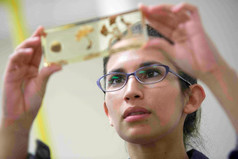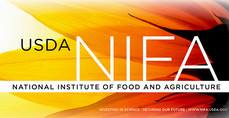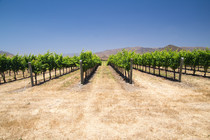| Having trouble viewing this email? View it as a Web page.  | | | Editor: Kelly Sprute August 11, 2021 Making a Difference  Images of root architecture in the field show the cipk15 mutant corn genotype had significantly steeper angles compared to the wildtype genotype. Courtesy of Hannah Schneider Penn State University. Researchers Identify a Gene that Regulates the Angle of Root Growth in Corn The discovery of a gene that regulates the angle of root growth in corn is a new tool to enable the breeding of deeper-rooting crops with enhanced ability to take up nitrogen, according to an international team of researchers, led by Penn State University. The gene called ZmCIPK15 was found to be missing in a naturally occurring mutant corn line that grows roots at steeper angles that make them go deeper into the soil. Identifying a gene that controls the angle of root growth in corn, influencing the depth to which roots forage, is important because deeper roots have a greater ability to capture nitrogen. Corn with an enhanced ability to take up nitrogen has implications for the world's environment, economy, and food security. "Corn is the most important crop in the world. In rich countries like the U.S., the biggest energy, economic and environmental cost of growing corn is nitrogen fertilizer," said Penn State's College of Agricultural Sciences Professor Jonathan Lynch. "And more than half of the nitrogen fertilizer applied to corn is never even taken up. It's just wasted, washed deeper into the soil where it pollutes groundwater, and some of it goes into the atmosphere as the greenhouse gas, nitrous oxide. It's a massive problem." USDA's National Institute of Food and Agriculture helped support this research. For more information, read this Penn State News article. | |  Meet NIFA's New Global Climate Change Division Director Dr. Shafiqur (Shafi) Rahman grew up in a small village in Bangladesh and went to local schools for K-12. He earned his Bachelor of Science in Agricultural Engineering from Bangladesh Agricultural University, Masters of Engineering from Asian Institute of Technology, Thailand, and PhD from the University of Manitoba, Canada. Before joining North Dakota State University (NDSU) as an assistant professor in the Department of Agricultural and Biosystems Engineering, he did his post-doctorate at the Agriculture and Agri Food Canada in Ottawa; Iowa State University, and Texas A&M University. Before joining NIFA, Dr. Rahman was a professor at NDSU. For the last 20 years, he has been researching agricultural waste management and treatment, water quality, and air quality from agricultural and livestock production systems. He is extensively involved with the American Society of Agricultural and Biological Engineers (ASABE). Currently, he serves as the Technical Program Chair for the Plant, Animal and Facility Systems (PAFS) community and Chair of PAFS-50- Environmental Air Quality committee of ASABE. Since 2010 he has served as an associate editor for the ASABE Journals and as a reviewer for several peer-reviewed national and international journals. He received the "Outstanding Associate Editor" awards for ASABE Journals in 2017. Dr. Rahman also served as a USDA Agricultural Air Quality Task Force member in 2016-2018 and he is a fellow of LEAD 21. |  Become a Peer Review Panelist The National Institute of Food and Agriculture (NIFA) seeks qualified individuals to serve on peer review panels for grant applications. NIFA convenes peer review panels comprised of research, education, extension, and other subject matter experts to review competitive grant proposals. Panelist duties include reviewing proposals; drafting and submitting individual scores and written reviews; attending and participating in a panel meeting. NIFA needs your service to ensure our peer review panels have the required expertise, while remaining inclusive, representative, and diverse. If you are interested in participating, NIFA uses a Peer Review System (PRS), to acquire volunteer sign-up. For more information, go to NIFA's panelist information. Panel discussion graphic, courtesy of Getty Images. |  Hispanic-Serving Institutions Spotlight: 3eX-Ag at Texas State University Our nation is faced with two education problems: ethnic disparity in postsecondary degree recipients and too few qualified graduates to fill requisite positions in the agriculture workforce. 3eX-Ag addresses these problems by positioning underrepresented students majoring in Agricultural Sciences at Texas State University for academic and professional success. 3eX-Ag is a collaborative effort between Dr. Merritt Drewery and Dr. Ryan Anderson of Texas State University and Dr. Tryon Wickersham of Texas A&M University. Through the program's four years, students at Texas State University complete original research with program directors, participate in a tour of production agriculture in the Texas panhandle, and/or interface with agricultural producers. For more information, read this NIFA blog by guest author Texas State University's Merritt Drewery PhD. A student looks at a slide with plant specimens, courtesy of Texas State University. |  Farmers Markets: Local Partners in the Nutrition Incentive Field The first week of August marks the annual National Farmers Market Week, an occasion celebrating the immense value farmers markets bring to local communities. Nationwide, farmers markets continue to fill a growing consumer demand for fresh and locally grown or produced foods including fruits and vegetables. NIFA's Gus Schumacher Nutrition Incentive Program (GusNIP) partners with farmers markets, farm stands, community supported agriculture and mobile markets by providing incentives for fruits and vegetables. GusNIP brings together stakeholders from food and healthcare systems to improve participant nutrition and health. For more information, read this NIFA blog. A couple shops at a local farmers market, courtesy of Getty Images. |  NIFA Career Opportunities We are hiring! The National Institute of Food and Agriculture (NIFA) recruits a diverse group of talented, creative, motivated professionals who are invested in shaping the future of food and agricultural science. We offer a variety of benefits and services to our employees that focus on work-life balance, career enhancement, and health and well-being. NIFA has career opportunities in a variety of scientific disciplines covering engineering, food science, forestry, education, animal and crop sciences, and many other agriculture-related disciplines. NIFA job openings are listed on USAJobs. Current NIFA job openings are for Kansas City, Missouri, or location negotiable after selection. Grants Management Specialist (GS 9-12)
Duty Station: Kansas City, MO or Negotiable After Selection
Closing Date: 08/16/2021 or upon receipt of 150 applications
View the all citizens job announcement or the merit promotion job announcement (mainly for government employees) Public Affairs Specialist (External Communications Manager) (GS 13-14)
Duty Station: Kansas City, MO or Negotiable After Selection
Closing Date: 08/20/2021 or upon receipt of 100 applications
View the all citizens job announcement. Public Affairs Specialist (Internal Communications Manager) (GS 13-14)
Duty Station: Kansas City, MO or Negotiable After Selection
Closing Date: 08/20/2021 or upon receipt of 100 applications
View the all citizens job announcement. Financial Officer (GS 14-15)
Duty Station: Kansas City, MO or Negotiable After Selection
Closing Date: 08/23/2021 or upon receipt of 150 applications
View the all citizens job announcement or the merit promotion job announcement (mainly for government employees) |  USDA Hosts Roundtable on Food Waste Solutions in the U.S. and Abroad The U.S. Department of Agriculture (USDA) will host a virtual roundtable on September 15 (11 a.m. – 12:30 p.m. ET) titled Exploring Food Waste Solutions: Success Stories from the U.S. and Beyond, to showcase innovative policies and approaches to reducing food waste in the United States, Europe, and the United Kingdom. "Food loss and waste reduction is an international priority – the United Nations has set a goal to cut food waste in half by 2030 as well as reduce food loss earlier in the supply chain," said USDA Food Loss and Waste Liaison Jean Buzby. "The United States also has a national goal to reduce food loss and waste by 2030. It's important to share the work of the people and organizations who are making this goal a reality in their communities." Go online for more information, or to register for this event. Food waste image, courtesy of Adobe Stock. |  Resources for Drought Plagued Producers In efforts to help farmers and ranchers mitigate impacts of drought, the USDA is combining both traditional and pilot programs to give producers greater flexibilities to overcome challenges to their crops and livestock. USDA's Rod Bain talks with Risk Management Agency Acting Administrator Richard Flournoy, Farm Service Agency Administrator Zach Ducheneaux, and Natural Resources Conservation Service Chief Terry Cosby as they discuss USDA programs to mitigate the impacts of drought in this edition of Agriculture USA. For more information, listen to this USDA broadcast. California grapevines, image courtesy of Adobe Stock. |  Enhancing Coordination Between Land-grant Universities and Colleges Land-grant Universities and Colleges have historically played important roles in research, education, and the distribution of information and practices to support America's highly productive agriculture community. A Blue Ribbon Panel will explore how enhanced coordination, collaboration, and integration within the Land-grant University System can increase the impact of research, education, and extension on the success of U.S. agriculture as it addresses new competitive challenges, pressures on environmental systems, and demands from consumers. The Blue Ribbon Panel will explore the opportunities and limitations of inter-institutional projects by focusing on case studies chosen from the portfolio of past Multistate Research and Extension Activities, Coordinated Agricultural Projects (CAP) of the Agriculture and Food Research Initiative (AFRI), and other regional initiatives involving research, education, and extension. For more information or to submit a nomination for committee members and/or reviewers by Wednesday, August 18, go online to the National Academies of Sciences Engineering and Medicine. Sunset at Cornell University, a land-grant research university, courtesy of Adobe Stock. |  Bringing Leading-Edge Digital Agriculture Teaching and Learning to Secondary Schools Purdue University is retooling its online Precision Agriculture course and adding a target audience: high school agriculture teachers. The revamped course with a focus on digital agriculture, developed with a grant from the U.S. Department of Agriculture, will be made available at no charge to high school agriculture teachers, starting in Indiana and then around the country. The $300,000 "Growing the Workforce for Digital Agriculture" grant is from USDA's National Institute of Food and Agriculture and was awarded under the Professional Development for Agricultural Literacy Program as part of the Agriculture and Food Research Initiative. For more information, read this Purdue University News article. Online precision agriculture course graphic, courtesy of Purdue University. | NIFA Invests $3 million in Funding for Alaska Native-Serving and Native Hawaiian-Serving Institutions NIFA recently announced five grants to strengthen the ability of Alaska-Native-Serving and Native Hawaiian-Serving Institutions (ANNH) to carry out education, applied research, and related community development programs. ANNH's purpose is to address educational needs, as determined by each institution, within a broadly defined arena of food and agricultural sciences-related disciplines. Priority will be given to those projects that enhance educational equity for underrepresented students; strengthen institutional educational capacities; prepare students for careers related to the food, agricultural, and natural resource systems of the United States; and maximize the development and use of resources to improve food and agricultural science teaching programs.  | | | NIFA's mission is to invest in and advance agricultural research, education, and extension that solve societal challenges. NIFA's investments in transformative science directly support the long-term prosperity and global preeminence of U.S. agriculture. Keep informed about NIFA, USDA, our land-grant and non-land-grant university partners, and stakeholders with the NIFA Update. Read past issues online, sign up for email updates or follow us on Twitter @USDA_NIFA, #NIFAImpacts or LinkedIn @usda-nifa. If you wish to submit a news item or information, send an email to NIFAUpdate. USDA is an equal opportunity lender, provider, and employer. | | | |

No comments:
Post a Comment